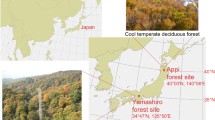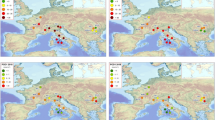Abstract
Tropospheric ozone (O3) is a critical threat to forest ecosystems. A stomatal flux-based risk evaluation methodology at the leaf level was established recently in the context of the Convention on Long-Range Transboundary Air Pollution (LRTAP). This study demonstrates improvement and validation of the stomatal flux-effect approach for adult beech with results from the 8-year free-air O3 enrichment experiment at “Kranzberger Forst” (Germany). The risk assessment module of the SVAT model FO3REST, being under development for local scale O3-risk assessment of adult beech stands, was parameterized according to the LRTAP Convention’s Mapping Manual. Mean maximum stomatal conductance for water vapour of 245 mmol H2O m−2 PLA s−1, as suggested in the LRTAP Convention’s Mapping Manual for beech, was affirmed by assessment at “Kranzberger Forst”, resulting in 162 mmol O3 m−2 PLA s−1 upon recommended adjustment of the O3/water vapour diffusivity ratio to 0.663. Based on this ratio, a provisional corrected flux-effect function was deduced. Modelled Phytotoxic O3 Doses (POD 1) and potential O3-caused losses in biomass formation estimated with a site-specific stomatal conductance algorithm differed slightly only from estimates by the original LRTAP parameterisation. Analysis-derived POD 1 target value within the meaning of Article 2 of the European Council Directive 2008/50/EC of 10 mmol O3 m−2 corresponded to potential loss in biomass formation of about 10 % in ambient air relative to “pre-industrial” conditions. However, exceedance occurred by about a factor of two during the study period, indicating high risk at “Kranzberger Forst” under ambient air. Assessment for doubled O3 exposure indicated potential underestimation even of the O3 risk because modelled losses in biomass formation are in the lower range of the standard deviation of the observed ones.




Similar content being viewed by others
Notes
LRTAP Convention (2010): "The projected leaf area (PLA, m2) is the total area of the sides of the leaves that are projected towards the sun. PLA is in contrast to the total leaf area, which considers both sides of the leaves. For horizontal leaves the total leaf area is simply 2*PLA."
References
Braun S, Flückiger W (1995) Effects of ambient ozone on seedlings of Fagus sylvatica L. and Picea abies (L.) Karst. New Phytol 129:33–44
Dämmgen U, Grünhage L (1998) Response of a grassland ecosystem to air pollutants. V. A toxicological model for the assessment of dose-response relationships for air pollutants and ecosystems. Environ Pollut 101:375–380
Dämmgen U, Grünhage L, Haenel HD, Jäger HJ (1993) Climate and stress in ecotoxicology. A coherent system of definitions and terms. Angew Bot 67:157–162
EU (2008) Council Directive 2008/50/EC of the European Parliament and of the Council of 21 May 2008 on ambient air quality and cleaner air for Europe. Offic J Eur Union L152:1–44
Grünhage L, Haenel HD (2008) Detailed documentation of the PLATIN (PLant-ATmosphere INteraction) model. Landbauforsch Volk special issue 319: 1–85. (Available at http://www.uni-giessen.de/cms/ukl-en/PLATIN)
Grünhage L, Jäger HJ (1996) Critical levels for ozone, ozone exposure potentials of the atmosphere or critical absorbed doses for ozone: a general discussion. In: Kärenlampi L, Skärby L (eds) Critical levels for ozone in Europe: testing and finalizing the concepts. UN-ECE workshop report. University of Kuopio, Department of Ecology and Environmental Science, Kuopio, pp 151–168
Grünhage L, Braden H, Bender J, Burkart S, Lehmann Y, Schröder M (2011) Evaluation of the ozone-related risk for winter wheat at local scale with the CRO3PS model. Gefahrst Reinhalt L 71:90–97 (available at http://www.uni-giessen.de/cms/CRO3PS)
Grünhage L, Pleijel H, Mills G, Bender J, Danielsson H, Lehmann Y, Castell JF, Bethenod O (2012) Updated stomatal flux and flux-effect models for wheat for quantifying effects of ozone on grain yield, grain mass and protein yield. Environ Pollut 165:147–157
Hammel K, Kennel M (2001) Charakterisierung und Analyse der Wasserverfügbarkeit und des Wasserhaushalts von Waldstandorten in Bayern mit dem Simulationsmodell BROOK90. Forstliche Forschungsberichte No. 185, München
Hayes F, Mills G, Harmens H, Norris D (2007) Evidence of widespread ozone damage to vegetation in Europe. ICP Vegetation Programme Coordination Centre, Centre for Ecology and Hydrology, Bangor, pp 58. http://icpvegetation.ceh.ac.uk)
Jarvis PG (1976) The interpretation of the variations in leaf water potential and stomatal conductance found in canopies in the field. Philos T R Soc B 273:593–610
Karnosky DF, Werner H, Holopainen T, Percy K, Oksanen T, Oksanen E, Heerdt C, Fabian P, Nagy J, Heilman W, Cox R, Nelson N, Matyssek R (2007) Free-air exposure systems to scale up ozone research to mature trees. Plant Biol 9:181–190
Kitao M, Löw M, Heerdt C, Grams TEE, Häberle K-H, Matyssek R (2009) Effects of chronic elevated ozone exposure on gas exchange responses of adult beech trees (Fagus sylvatica) as related to the within-canopy light gradient. Environ Pollut 157:537–544
Löw M, Herbinger K, Nunn AJ, Häberle K-H, Leuchner M, Heerdt C, Werner H, Wipfler P, Pretzsch H, Tausz M, Matyssek R (2006) Extraordinary drought of 2003 overrules ozone impact on adult beech trees (Fagus sylvatica). Trees 20:539–548
LRTAP Convention (2010) Mapping Manual 2004. Manual on methodologies and criteria for modelling and mapping critical loads & levels and air pollution effects, risk and trends. chap 3, Mapping critical levels for vegetation. 2010 revision. (Available at http://icpvegetation.ceh.ac.uk)
Mason EA, Kronstadt B (1967) Graham’s laws of diffusion and effusion. J Chem Educ 44:740–744
Massman WJ (1998) A review of the molecular diffusivities of H2O, CO2, CH4, CO, O3, SO2, NH3, N2O, NO, and NO2 in air, O2 and N2 near STP. Atmos Environ 32:1111–1127
Massman WJ (1999) Molecular diffusivities of Hg vapor in air, O2 and N2 near STP and the kinematic viscosity and thermal diffusivity of air near STP. Atmos Environ 33:453–457
Massman WJ, Musselman RC, Lefohn AS (2000) A conceptual ozone dose-response model to develop a standard to protect vegetation. Atmos Environ 34:745–759
Matyssek R, Sandermann H (2003) Impact of ozone on trees: an ecophysiological perspective. Prog Bot 64:349–404
Matyssek R, Wieser G, Nunn AJ, Kozovits AR, Reiter IM, Heerdt C, Winkler JB, Baumgarten M, Häberle K-H, Grams TEE, Werner H, Fabian P, Havranek WM (2004) Comparison between AOT40 and ozone uptake in forest trees of different species, age and site conditions. Atmos Environ 38:2271–2281
Matyssek R, Bytnerowicz A, Karlsson PE, Paoletti E, Sanz M, Schaub M, Wieser G (2007) Promoting the O3 flux concept for European forest trees. Environ Pollut 146:587–607
Matyssek R, Sandermann H, Wieser G, Booker F, Cieslik S, Musselman R, Ernst D (2008) The challenge of making ozone risk assessment for forest trees more mechanistic. Environ Pollut 156:567–582
Matyssek R, Wieser G, Ceulemans R, Rennenberg H, Pretzsch H, Haberer K, Löw M, Nunn AJ, Werner H, Wipfler P, Oßwald W, Nikolova P, Hanke DE, Kraigher H, Tausz M, Bahnweg G, Kitao M, Dieler J, Sandermann H, Herbinger K, Grebenc T, Blumenröther M, Deckmyn G, Grams TEE, Heerdt C, Leuchner M, Fabian P, Häberle K-H (2010) Enhanced ozone strongly reduces carbon sink strength of adult beech (Fagus sylvatica)—resume from the free-air fumigation study at Kranzberg Forest. Environ Pollut 158:2527–2532
McNaughton KG, van den Hurk BJJM (1995) A ‘Lagrangian’ revision of the resistors in the two-layer model for calculating the energy budget of a plant canopy. Bound-Lay Meteorol 74:261–288
Mills G, Pleijel H, Braun S, Büker P, Bermejo V, Calvo E, Danielsson H, Emberson L, Gonzáles Fernández I, Grünhage L, Harmens H, Hayes F, Karlsson P-E, Simpson D (2011) New stomatal flux-based critical levels for ozone effects on vegetation. Atmos Environ 45:5064–5068
Musselman RC, Massman WJ (1999) Ozone flux to vegetation and its relationship to plant response and ambient air quality standards. Atmos Environ 33:65–73
Musselman RC, Lefohn AS, Massman WJ, Heath RL (2006) A critical review and analysis of the use of exposure- and flux-based ozone indices for predicting vegetation effects. Atmos Environ 40:1869–1888
Nunn AJ, Reiter IM, Häberle K-H, Werner H, Langebartels C, Sandermann H, Heerdt C, Fabian P, Matyssek R (2002) “Free-air” ozone canopy fumigation in an old-growth mixed forest: concept and observations in beech. Phyton (Austria) Special issue: Global change 42: 105–119
Nunn AJ, Kozovits AR, Reiter IM, Heerdt C, Leuchner M, Lütz C, Liu X, Löw M, Winkler JB, Grams TEE, Häberle K-H, Werner H, Fabian P, Rennenberg H, Matyssek R (2005) Comparison of ozone uptake and sensitivity between a phytotron study with young beech and a field experiment with adult beech (Fagus sylvatica). Environ Pollut 137:494–506
Nunn AJ, Wieser G, Metzger U, Löw M, Wipfler P, Häberle K-H, Matyssek R (2007) Exemplifying whole-plant ozone uptake in adult forest trees of contrasting species and site conditions. Environ Pollut 146:629–639
Nunn AJ, Cieslik S, Metzger U, Wieser G, Matyssek R (2010) Combining sap flow and eddy covariance approaches to derive stomatal and non-stomatal O3 fluxes in a forest stand. Environ Pollut 158:2014–2022
Paoletti E, Manning WJ (2007) Toward a biologically significant and usable standard for ozone that will also protect plants. Environ Pollut 150:85–95
Pretzsch H, Dieler J, Matyssek R, Wipfler P (2010) Tree and stand growth of mature Norway spruce and European beech under long-term ozone fumigation. Environ Pollut 158:1061–1070
Stewart JB (1988) Modelling surface conductance of pine forest. Agr Forest Meteorol 43:19–35
Uddling J, Günthardt-Goerg MS, Matyssek R, Oksanen E, Pleijel H, Selldén G, Karlsson PE (2004) Biomass reduction of juvenile birch is more strongly related to stomatal uptake of ozone than to indices based on external exposure. Atmos Environ 38:4709–4719
Werner H, Fabian P (2002) Free-air fumigation of mature trees. A novel system for the controlled ozone enrichment in grown-up beech and spruce canopies. Environ Sci Pollut R 9:117–121
Wieser G, Matyssek R, Köstner B, Oberhuber W (2003) Quantifying ozone uptake at the canopy level of spruce, pine and larch trees at the alpine timberline: an approach based on sap flow measurement. Environ Pollut 126:5–8
Wieser G, Matyssek R, Götz B, Grünhage L (2012) Branch cuvettes as means of ozone risk assessment in adult forest tree crowns: combining experimental and modeling capacities. Trees. doi:10.1007/s00468-012-0715-6
Author information
Authors and Affiliations
Corresponding author
Additional information
Communicated by F. Mohren.
Special topic: Integrating Modeling and Experiment.
Rights and permissions
About this article
Cite this article
Grünhage, L., Matyssek, R., Häberle, KH. et al. Flux-based ozone risk assessment for adult beech forests. Trees 26, 1713–1721 (2012). https://doi.org/10.1007/s00468-012-0716-5
Received:
Revised:
Accepted:
Published:
Issue Date:
DOI: https://doi.org/10.1007/s00468-012-0716-5




